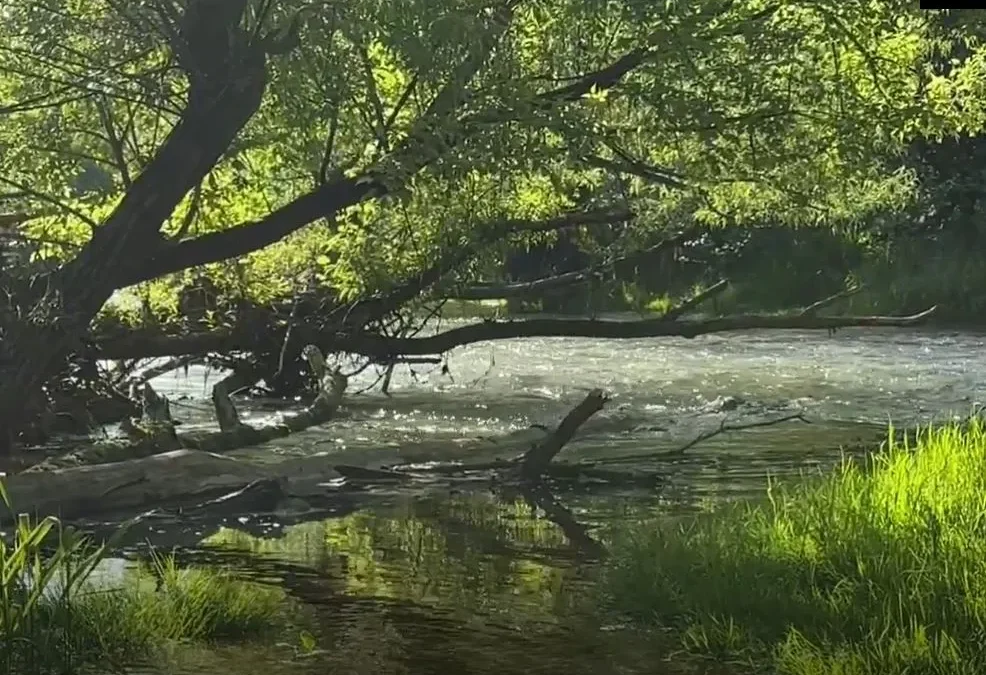In the wild, peace and quiet come wrapped in water, thunder, birdsong, and snake rattles. What a relief!
I’m an introvert. Too much conversation, ringing phones, the constant pinging of message notifications on my mobile, pile up in my brain like fall leaves in a gutter. My thinking gets clogged and any hope for creative productivity goes out the window.
Yes, I could pop on noise-cancelling earphones. Close my door. Turn off the phone. But modern life is intrusive. It’s loud, demanding, and constant.
Much as it appeals to me, holing up in a cave isn’t an option. Instead, my go-to response is to take a mental break by slipping away to the nearby wooded park in search of blessed silence.
What I find always comes as a surprise: Nature isn’t silent.
The wild is filled with sound, more like a gentle tap on the shoulder than the push and shove of life’s daily din. In the woods, surrounded by a wall of evergreen and maple trees that mutes the road traffic and nearby construction machinery, the hush I expect emerges as a gentle symphony. Rather than a vacuum devoid of sound, I encounter a world filled with music: melodious, rhythmic, and harmonious that becomes an invitation to pay attention.
The fullness of quiet
Author Kim Haines-Eitzen writing about the monastic experience of ancient Christianity ponders this paradox in her book Sonorous Desert. When she goes off into the barren lands with a recorder intending to capture the silence of these arid places, she discovers, instead, that even remoteness contains sound. Beyond her own breathing and heartbeat, she hears the cackle of ravens, wind howling through caves, the burbling of nearby water. Such sounds, she notes, force us to listen and give attention to not only what is outside us, but to what is within. They are sounds that lure us into meditation. Solace. A sense of solitude to which the desert fathers and mothers escaped to quench their thirst for Divine communion.
I have the same experience the further I walk into the woods: my hearing sharpens. Sounds become amplified. The breeze rustles leaves. Squirrels skitter across branches. A limb cracks. Water splashes when something startles the turtle sunning itself on a log and it slips into the brackish pond. Cut off from the noise of motors, pings, and voices, a space opens where I can dwell peacefully, in a timeless pause, surrounded by birdsong and wind.
Nature’s silence is not one of absence but something more. As Haines-Eitzen observed from her many treks into the desert this quality is one of the “fullness of quiet, a blooming attention, moments where time slows.”
I discovered while deepening my relationship with nature during the COVID years, that embracing the fullness of quiet takes discipline and intention. Walking to “sort your thoughts out” keeps you focused on your own voice and distracting mental chatter. You miss the sonorous biosphere all around you. With focused attention you become a receiver, both ears wide open to simply listen. Be still, and nature rewards you with delight. Joy. Peace.
Want to learn the steps to rebalance and recharge your life? Check out my FREE eBook, CENTERING IN NATURE.
Entering a receptive mode
Focusing attention can be a challenge some days, especially when I’m stressing over a new project or some inter-office drama. We all have them. Here are a few simple steps to get into a receptive mode:
- Have a place where you can experience silence, solitude, and seclusion. This can be your own home garden, a walking trail that leads away from roads, or a favorite park where there are nooks and pockets of trees where you can be alone, wrapped in nature.
- Take off the earbuds and silence your phone. Close your eyes and listen to your own breath so that you still your thoughts.
- Notice what you hear close by: What sounds are in the trees above, the ground under your feet. Listen with curiosity. What’s that crunching sound? Where is the tapping of a woodpecker coming from?
- Widen your range of hearing: What can you hear in the distance? Gather in these sounds as if you are creating an audible picture. What is loud? What is barely a whisper? What attracts you and pulls you into listen more fully? How is nature speaking to you?
- If feelings and questions arise, treat them as gifts. The monastics sought out remote places for enlightenment and to ease their spirits. Welcome insight and rest quietly with whatever emerges.
Mindfully immersing our senses in nature, its colors, fragrances, textures, and sounds, offers respite but also the ability to be fully present in the moment. For a short time, we are not reliving the past or projecting into the future, but are present in the now. We can just be.
Elle Harrigan is a Transformational Facilitator and author. A Certified Intuition Practitioner (CIP), she is currently working on a book focused on cultivating sensory mindfulness in nature to create resilience, empowerment, and well-being. You can find her on Instagram @livingwildwisdom.

